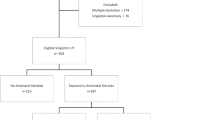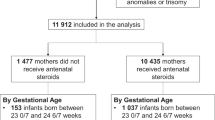Abstract
Objective:
Antenatal steroid use has been associated with reduction in the risk of neonatal mortality in meta-analyses of clinical trials. In 2007, a revised US birth certificate offered information on antenatal steroid use in 22 states. The aim of this study was to review the association between antenatal steroid use and neonatal mortality by gestational age categories for preterm infants (<37 weeks) for the United States for the year 2007.
Study Design:
Data were obtained from the United States Linked Infant Birth and Death Certificate Public Use Period file for the year 2007. Associations between antenatal steroid use and neonatal death were determined by logistic regression adjusting for potentially confounding variables.
Result:
There were 245 453 preterm births and 4220 neonatal deaths available for analysis with complete data on antenatal steroid use. The highest prevalence for antenatal steroid use among neonatal intensive care unit admissions (NICU) was 22% in the 26 to 28 week gestational age category, whereas the lowest prevalence was in the 34- to 36-week group at 7%. Following adjustment for potentially confounding variables by logistic regression, the adjusted odds ratios (95% confidence interval) for neonatal mortality (antenatal steroid use versus non-use) ranged from 0.56 (0.46 to 0.67) at 22 to 25 weeks; 0.66 (0.53 to 0.83) at 26 to 28 weeks; 0.69 (0.55 to 0.85) at 29 to 33 weeks and 0.69 (0.47 to 1.01) at 34 to 36 weeks.
Conclusion:
These data are in accordance with meta-analytical data of randomized clinical trials and network reports on reduction of neonatal mortality with the use of antenatal steroids, and provide support for the use of antenatal steroids for late preterm births.
This is a preview of subscription content, access via your institution
Access options
Subscribe to this journal
Receive 12 print issues and online access
$259.00 per year
only $21.58 per issue
Buy this article
- Purchase on Springer Link
- Instant access to full article PDF
Prices may be subject to local taxes which are calculated during checkout
Similar content being viewed by others
References
National Institutes of Health Consensus Statement. The effect of antenatal steroids for fetal maturation on perinatal outcomes-interim draft statement. NIH Consensus Statement Online 1994; 12 (2): 1–24.
Royal College of Obstetricians and Gynaecologists. Antenatal Corticosteroids to Reduce Neonatal Morbidity and Mortality. Green-top guideline No. 7, October 2010 Online at http://www.rcog.org.uk/files/rcog-corp/GTG%207.pdf (last contacted 8/16/2011).
Dalziel RD . Antenatal corticosteroids for accelerating fetal lung maturation for women at risk for preterm birth. Cochrane Database of Syst Rev 2010; (9). Art. No: CD004454.
Liggins GC, Howie RN . A controlled trial of antepartum glucocorticoid treatment for prevention of the respiratory distress syndrome in premature infants. Pediatrics 1972; 50: 515–525.
Collaborative Group on Antenatal Steroid Therapy. Effect of antenatal dexamethasone administration on the prevention of respiratory distress syndrome. Am J Obstet Gynecol 1981; 141: 276–287.
Costeloe K, Hennessy E, Gibson AT, Marlow N, Wilkinson AR . The EPICure study: outcomes to discharge from hospital for infants born at the threshold of viability. Pediatrics 2000; 106: 659–671.
Tyson JE, Parikh NA, Langer J, Green C, Higgins RD . Intensive care for extreme prematurity--moving beyond gestational age. N Engl J Med 2008; 358: 1672–1681.
Markestad T, Kaaresen PI, Ronnestad A, Reigstad H, Lossius K, Medbo S et al. Early death, morbidity, and need of treatment among extremely premature infants. Pediatrics 2005; 115: 1289–1298.
Manktelow BN, Lal MK, Field KJ, Sinha SK . Antenatal corticosteroids and neonatal outcomes according to gestational age: a cohort study. Arch Dis Child Fetal Neonatal Ed 2010; 95: F95–F98.
Horbar JD, Badger GJ, Carbenter JH, Fanaroff AA, Kilpatrick S, LaCorte M et al. Trends in mortality and morbidity for very low birth weight infants, 1991-1999. Pediatrics 2002; 110: 143–151.
National Center for Health Statistics. US Standard Certificate of Life Birth 2003 Revision. http://www.cdc.gov/nchs/nvss/vitalcertificaterevisions.htm (last accessed 3/12/2012).
Osterman MJK, Martin JA, Menacker F . Expanded health data from the new birth certificate, 2006. Natl Vital Stat Rep 2009; 58 (5): 1–24.
National Center for Health Statistics. Linked Birth/Infant Death Period File 2006, http://www.cdc.gov/nchs/data_access/Vitalstatsonline.htm (Last accessed 3/12/2012).
National Center for Health Statistics. Linked Birth/Infant Death Period File 2007, http://www.cdc.gov/nchs/data_access/Vitalstatsonline.htm (Last accessed 3/12/2012).
Carlos WA, McDonald SA, Fanaroff AA, Vohr BR, Stoll BJ, Ehrenkranz RA et al. Association of antenatal corticosteroids with mortality and neurodevelopmental outcomes among infants born at 22 to 25 weeks' gestation. JAMA 2011; 306 (21): 2348–2358.
Hamilton BE, Martin JA, Ventura SJ . Births: preliminary data for 2007. Natl Vital Stat Rep 2009; 57 (12): 1–14.
Martin JA, Hamilton BE, Sutton PD, Ventura MA, Menacker F, Kimeyer S et al. Births: final data for 2006. Natl Vital Stat Rep 2009; 57 (7): 1–104.
Bottoms SF, Paul RH, Iams JD, Mercer BM, Thom EA, Roberts JM et al. Obstetric determinants of neonatal survival: influence of willingness to perform cesarean delivery on survival of extremely low-birth-weight infants. Am J Obstet Gynecol 1997; 176: 960–966.
Rothman KJ . Modern Epidemiology. Little, Brown and Company: Boston/Toronto, 1986, pp 82–87.
National Center for Health Statistics. Vital Statistics of the United States, 2003: Technical Appendix, Natality. National Center for Health Statistics: Hyattsville, MD, 2005, pp 26–27.
National Center for Health Statistics. Instruction manual Part 12: Computer Edits for Natality Data, Effective 1993:Vital Statistics, Data Preparation. National Center for Health Statistics: Hyattsville, MD, 1995, pp 33–35.
Malloy MH . The Born-Alive Infant Protection Act: impact on fetal and live birth mortality. Am J Perinatol 2011; 28: 399–404.
Acknowledgements
This analysis was presented in part at the Annual Meeting of the Pediatric Academic Societies in Denver, Colorado, 2 May, 20011.
Author information
Authors and Affiliations
Corresponding author
Ethics declarations
Competing interests
The author declares no conflict of interest.
Rights and permissions
About this article
Cite this article
Malloy, M. Antenatal steroid use and neonatal outcome: United States 2007. J Perinatol 32, 722–727 (2012). https://doi.org/10.1038/jp.2012.22
Received:
Revised:
Accepted:
Published:
Issue Date:
DOI: https://doi.org/10.1038/jp.2012.22
Keywords
This article is cited by
-
Care Practices, Morbidity and Mortality of Preterm Neonates in China, 2013–2014: a Retrospective study
Scientific Reports (2019)
-
The Joint Effects of Antenatal Steroids and Gestational Age on Improved Outcomes in Neonates
Maternal and Child Health Journal (2018)



